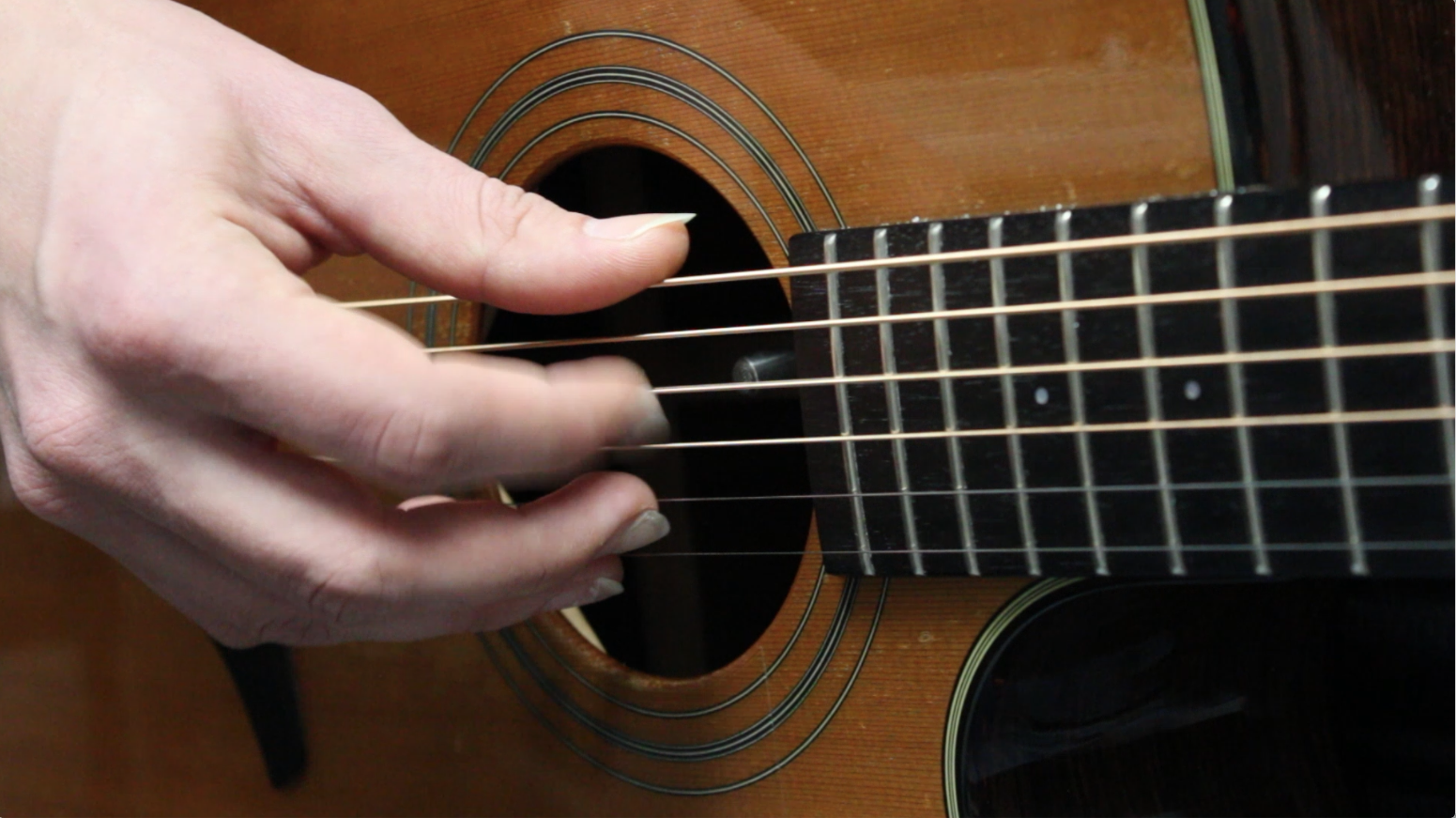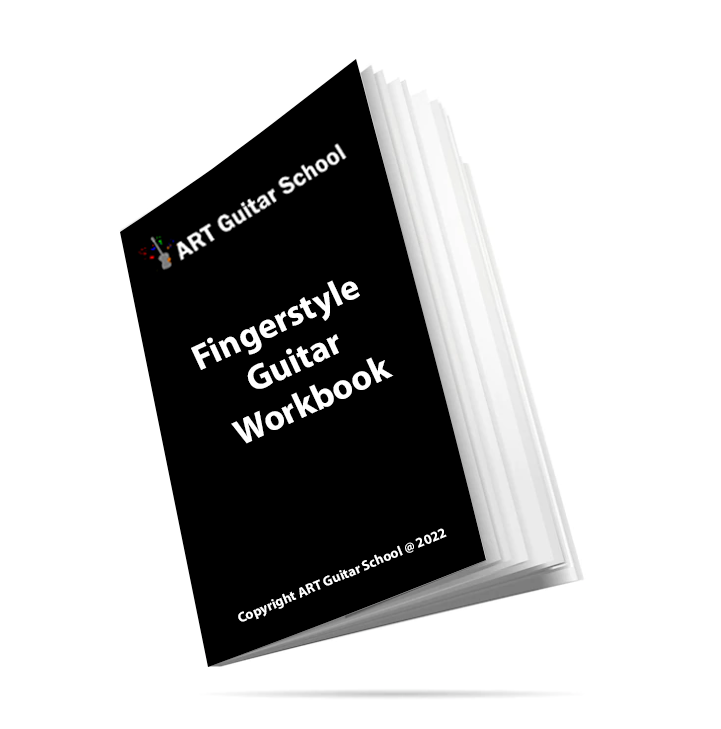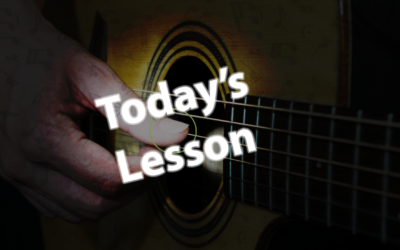FINGERPICKING KEY

The right hand:
P = Thumb
I = Index
M = Middle
A = Ring
Fingerpicking Pattern No. 1
This is the most essential fingerpicking pattern to start with. It requires no left hand chord or fretted notes. It is used in many popular fingerpicking songs and some songs are slight variations of this same pattern.
We have all open strings being plucked in sequential order. Each note is a quarter note in duration and will last exactly one second each if played at 60bpm.
Lets get to playing!
We will pluck each open string in order starting from the 6th string (Low E) and ending on the 1st (High E).
Step 1. Lets start with thumb (p) and pluck the 6th-4th string
Step 2. Pluck index (i), middle (m) and ring (a) on the 3rd-1st strings.

Here is a video demonstration of the finger picking pattern:
If you were having trouble please contact us and we will help you!
FOLLOW US ON
Get our FREE Fingerstyle Workbook!
RELATED BLOG POSTS
The Basics of Fingerstyle Guitar: An Introduction
If you’re new to guitar, you’ve probably come across the term “fingerstyle” and wondered what makes it different from regular flatpicking. Fingerstyle guitar is a beautiful, versatile technique that allows you to create intricate melodies, harmonies, and rhythms all at once using just your fingers. Whether you’re drawn to acoustic or classical guitar, fingerstyle can add a whole new level of depth to your playing.
In this post, we’ll dive into the basics of fingerstyle guitar, break down the technique, and give you a solid foundation to start your fingerpicking journey. What is Fingerstyle Guitar?
Fingerstyle guitar is a technique where the player uses their fingers (instead of a pick) to pluck the strings. The thumb typically handles the bass notes (usually on the lower strings), while the fingers (index, middle, and sometimes ring) handle the melody and harmony on the higher strings.
Fingerstyle differs from flatpicking, where a pick is used to strike the strings, allowing more nuanced control over dynamics and tone. It also enables you to play multiple voices at once, combining basslines, chord progressions, and melodies in a single performance.
Key Concepts to Understand Fingerstyle
Before you start playing, let’s break down some essential concepts.
1. Hand Positioning
Proper hand positioning is crucial for comfortable and efficient fingerstyle playing.
Thumb: The thumb controls the bass notes and is responsible for playing the lower strings (usually the 6th, 5th, and 4th). It should move independently of the fingers, but all the movements should feel natural.
Fingers: Your index, middle, and ring fingers (sometimes the pinky too) are responsible for plucking the higher strings. These fingers should remain relaxed and curved, using the pads of the fingers to strike the strings.
2. Common Fingerstyle Patterns
At the heart of fingerstyle guitar are picking patterns that alternate between the thumb and fingers. One of the most common patterns is:
P (Thumb): Plays the bass note (6th, 5th, or 4th string).
I (Index): Plays the 3rd string.
M (Middle): Plays the 2nd string.
A (Ring): Plays the 1st string.
This pattern can be varied by adding syncopation, skipping strings, or using finger substitutions. But starting with this basic pattern will give you a solid foundation.
Getting Started: Basic Exercises
Exercise 1: Thumb and Finger Coordination
Start with a simple exercise to practice using your thumb and fingers independently.
Play a C major chord.
Use your thumb to pluck the 5th string (the root note).
Use your index finger to pluck the 3rd string.
Use your middle finger to pluck the 2nd string.
Keep the fingers relaxed and try to maintain a steady rhythm.
Repeat this exercise for several minutes to build muscle memory.
Exercise 2: Alternating Bass
Next, practice alternating between the thumb and fingers. Start with a simple C chord:
Thumb (P) plays the 5th string.
Index (I) plays the 3rd string.
Thumb (P) plays the 4th string.
Middle (M) plays the 2nd string.
This will help you develop coordination between the thumb and the fingers, which is essential in most fingerstyle patterns.
Conclusion
Fingerstyle guitar is a rewarding and expressive technique that opens up new possibilities for your playing. By starting with proper hand positioning and focusing on basic exercises, you’ll be on your way to mastering the technique. As you progress, you can experiment with more complex patterns, incorporate melody, and even explore various genres like folk, classical, and blues.
Stay patient, practice regularly, and you’ll see improvements before you know it. Happy playing!
Understanding Time Signatures in Fingerstyle Music
Time signatures are a fundamental aspect of all music, including fingerstyle guitar. They determine how many beats are in each measure and which note value receives the beat. In fingerstyle guitar, understanding time signatures helps you organize your rhythm and gives your playing a clear sense of structure. This is particularly important because fingerstyle often incorporates multiple voices—bass, melody, and harmony—into one performance. In this post, we’ll explain the basics of time signatures and how they apply to fingerstyle guitar.
1. What Is a Time Signature?
A time signature consists of two numbers written at the beginning of a piece of music, typically after the clef. The top number indicates how many beats are in each measure (or bar), while the bottom number tells you which note value gets the beat.
For example, a time signature of 4/4 means there are four beats in each measure, and a quarter note gets one beat. Similarly, 3/4 time means there are three beats in each measure, with a quarter note receiving one beat.
2. Common Time Signatures in Fingerstyle Guitar
4/4 Time (Common Time): This is the most common time signature in Western music and fingerstyle guitar. It means there are four beats per measure, and each beat is a quarter note. Most pop, rock, and folk songs are written in 4/4 time. In fingerstyle, this time signature allows for a steady, predictable rhythm that accommodates alternating bass patterns, arpeggios, and melodies.
3/4 Time: Also known as “waltz time,” 3/4 time consists of three beats per measure, with each beat being a quarter note. Fingerstyle pieces in 3/4 often have a flowing, waltz-like feel. It’s common in classical and folk music, where the thumb plays a steady bass pattern while the fingers handle the melody.
6/8 Time: In 6/8 time, there are six beats in a measure, and the eighth note receives one beat. This time signature is often used for slower, more lyrical fingerstyle pieces. It has a rolling feel, with accents typically on the first and fourth beats. It’s common in many traditional and classical fingerstyle songs.
3. How to Count Time Signatures in Fingerstyle Guitar
Understanding how to count time signatures is crucial to playing in time and maintaining a steady rhythm. Here’s a basic guide:
4/4 Time: Count 1-2-3-4. Each number represents a beat. You can emphasize the first beat (1) to give the rhythm a strong, grounded feel. In fingerstyle, you may play the bass notes with the thumb on the downbeats and the melody on the upbeats or offbeats.
3/4 Time: Count 1-2-3. Since there are three beats per measure, the melody often mirrors the three beats with a waltz-like rhythm. The thumb will usually handle the bass, while the fingers pick out the melody on the higher strings.
6/8 Time: Count 1-2-3-4-5-6, but with a “1-2-3” feel on the first three beats and “4-5-6” as a connected, faster movement. The thumb often alternates between bass notes, and the fingers play the higher notes in a more fluid pattern.
4. How Time Signatures Affect Fingerstyle Patterns
The time signature affects the structure and flow of fingerstyle patterns. In 4/4 time, for instance, the pattern might consist of alternating bass notes (played with the thumb) and melody notes (picked with the fingers). In 3/4 time, the bass notes might follow a more waltz-like pattern, providing a rhythmic pulse to the melody.
In more complex time signatures, like 6/8, fingerstyle players may emphasize a rolling or triplet feel, with the thumb playing a continuous bass line while the fingers pick out intricate melodies.
5. Playing with Syncopation and Polyrhythms
As you advance in fingerstyle guitar, you’ll encounter more complex rhythmic techniques, such as syncopation and polyrhythms. These rhythmic techniques are essential in adding complexity and variety to your playing, and they depend heavily on the time signature. Syncopation involves emphasizing offbeats or weaker beats, while polyrhythms occur when two different rhythmic patterns are played at the same time.
Conclusion
Time signatures are foundational to understanding rhythm in fingerstyle guitar. By recognizing how time signatures affect the rhythm and structure of your playing, you’ll be able to develop a stronger sense of timing and groove. Whether you’re playing in 4/4, 3/4, or 6/8, understanding time signatures allows you to play more expressively and with greater control, setting the stage for more intricate and creative fingerstyle arrangements.
Common Mistakes in Fingerstyle Playing and How to Avoid Them
Fingerstyle guitar, while rewarding, can also be a challenging technique to master. Many beginners make common mistakes that can impede their progress. Whether it’s poor hand positioning, inconsistent tone, or lack of finger independence, these mistakes can be corrected with practice and awareness. In this post, we’ll cover some of the most common mistakes in fingerstyle guitar and offer tips on how to avoid them.
1. Tension in the Hands and Wrists
One of the most common mistakes is playing with too much tension in the hands or wrists. This often leads to discomfort or even injury over time, and it can negatively affect your tone and accuracy. Tension makes it harder to achieve fluid movement, especially when transitioning between chords or picking patterns.
How to avoid it: Keep your hands relaxed and your wrists in a natural position. Ensure that your thumb is relaxed when playing bass notes, and try to avoid overextending your fingers or bending your wrist awkwardly. Pay attention to your posture and hand positioning to minimize tension. If you start feeling discomfort, take a short break and shake out your hands to release any built-up tension.
2. Inconsistent Timing
Timing is everything in fingerstyle guitar. Many beginners struggle with keeping a consistent rhythm, especially when playing more complex patterns or multiple voices simultaneously. Inconsistent timing can make your playing sound choppy or disconnected.
How to avoid it: Use a metronome to practice at a slow, steady tempo. Gradually increase the speed as you become more comfortable with the pattern. Start slow to develop a solid foundation of timing, and make sure each note is in the right place within the rhythm. It’s better to play slowly and accurately than to rush and lose the groove.
3. Poor Thumb Technique
The thumb is a critical part of fingerstyle guitar, particularly when playing bass notes. Beginners often use their thumb incorrectly, either by not using enough pressure or by not maintaining consistent contact with the strings. This can result in weak bass notes or missed strings.
How to avoid it: Practice keeping your thumb in a relaxed, controlled position, hovering over the bass strings. Your thumb should be playing with a firm but relaxed motion to produce a solid, consistent bass note. Focus on keeping your thumb close to the string to ensure precision and clarity. Over time, the thumb will become more natural and responsive.
4. Lack of Finger Independence
Finger independence is a hallmark of great fingerstyle guitar playing. Beginners often struggle with using their thumb for bass notes while the fingers pick melody and harmony notes. Lack of independence between the thumb and fingers can make it difficult to create smooth, flowing fingerstyle patterns.
How to avoid it: Start with simple exercises that focus on alternating between thumb and fingers. Practice playing bass notes with your thumb while your fingers handle melody or accompaniment. Slow, deliberate practice will help you develop finger independence and coordination.
5. Overplaying or Adding Too Many Notes
One mistake many beginners make is overcomplicating their fingerstyle pieces by adding too many notes or embellishments. While it’s tempting to fill every moment with notes, this can make the music feel cluttered and less expressive.
How to avoid it: Less is often more in fingerstyle guitar. Focus on creating space within the music and allowing each note to have its own importance. Use silence and rests to give the piece room to breathe. Focus on the quality of your notes, rather than the quantity.
6. Not Practicing Proper Finger Placement
Proper finger placement is essential for clean, precise fingerstyle playing. Beginners often struggle with finger placement, which can lead to buzzing notes or missed strings.
How to avoid it: Make sure each finger is placed correctly on the strings, close to the fret, and with enough pressure to produce a clean sound. Avoid pressing too hard, as this can mute the strings or cause unwanted buzzing.
Conclusion
Fingerstyle guitar can be an incredibly rewarding technique, but it requires patience, practice, and attention to detail. By avoiding common mistakes like tension, inconsistent timing, and poor thumb technique, you can build a strong foundation for your playing. Remember, progress comes with consistent practice, and by focusing on these key areas, you’ll be able to play fingerstyle with ease and musicality.




0 Comments